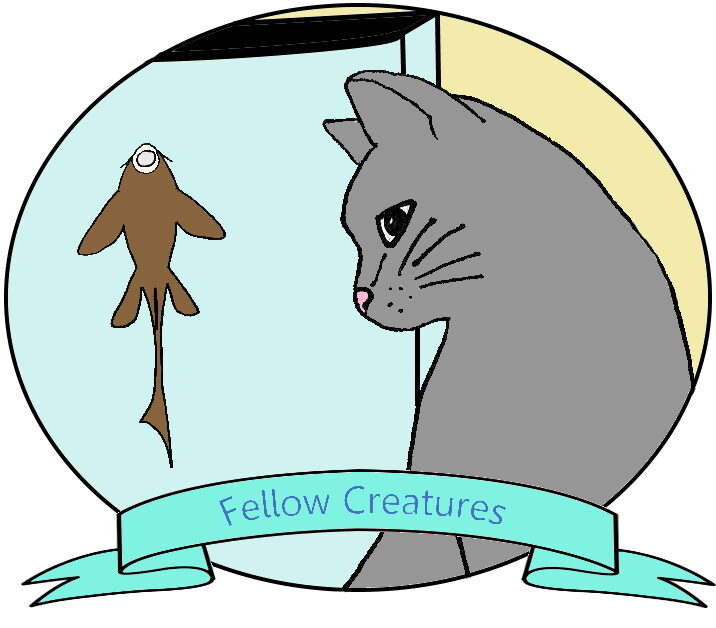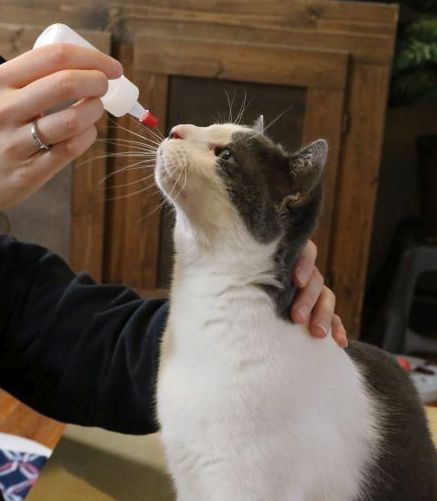What is cooperative care?
Cooperative care is when you train an individual to be an active participant in their care, not just allow you to do something.
Cooperative care isn’t all-or-nothing. It’s a spectrum, ranging from voluntary distraction to fully cooperative.
Voluntary distraction
Voluntary distraction is when the individual knows what’s about to happen – we aren’t trying to trick them – and they choose to engage in something as a distraction. This works best with infrequent procedures that are mildly annoying, but not really stressful. (Remember that what is considered stressful is up to the individual.)
It’s like when you engage in small talk with the nurse while getting a vaccine, assuming you don’t find vaccines to be very stressful.
Semi-cooperative
Semi-cooperative care is when the individual uses their behavior to signal you when to begin a procedure – most often by going on a station or targeting an object. They also have options to pause the procedure if they feel uncomfortable. It’s a better choice if the procedure happens frequently and has the potential to be unpleasant or stressful.
An example could be when you hold out your arm for the nurse to take your blood pressure, and you tell them you’re ready. If you freak out, you can ask the nurse to release the blood pressure cuff.
Fully cooperative
Fully cooperative is when the individual takes part in the procedure themself.
This is like when you pinch your skin so your friend can remove a sliver from your finger.
We often think of fully cooperative care as the gold standard, but it’s not appropriate for every procedure. If I’m having surgery, the surgeon does not want my conscious cooperation! I just need to cooperate for the anesthesia.
How did cooperative care get started?
Cooperative care started in the zoo world, with animals too big and dangerous to push around – like polar bears and orca whales. You can’t just hold them down and do a blood draw. And you can’t exactly dart an orca to sedate them. It’s cooperative or nothing.
Why is cooperative care important?
From a welfare perspective, cooperative care makes sense. Think about how you would feel if someone did something to you without your consent – tricked you by putting medicine in your milkshake, or held you down while giving you a vaccine as a kid. Just thinking about it is enough to make me feel triggered! Imagine how your cat must feel.
Most people want what’s best for their pets. Cooperative care is how we do better.
What about cats?
Too often, we do things to cats without thinking. We pick them up, shove them into a carrier, hold them down and give them an injection. We can do these things because cats are small, but just because we can do something doesn’t mean that we should. The excuse is that it’s faster, but the risk is that we traumatize the cat, damaging their trust and making it harder the next time. A cat that has a bad experience at the vet clinic as a kitten will become increasingly resistant as they get older, and then it’s harder for people to want to bring their cats in for the care they need.
What are some examples of cooperative care with cats?
Voluntary distraction
The cat looks at the brush, then turns their head, choosing to eat treats from the lick mat while you brush them.
The cat sees the scale. They choose to follow a treat and walk onto the scale.
Semi-cooperative
The cat sees the nail clippers and presents their paw for a nail trim.
The cat sees the harness and steps underneath it, allowing you to put it on.
The cat touches the brush with their nose, signaling you to begin brushing.
Fully cooperative
The cat goes into their carrier on cue.
The cat takes medicine voluntarily – either eating a pill or licking from a syringe.
The cat sees the toothbrush and rubs their teeth against it.
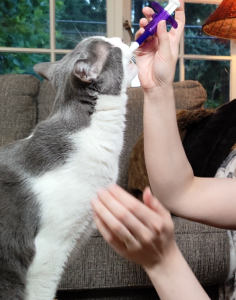

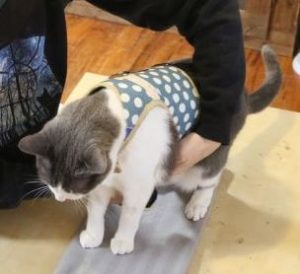
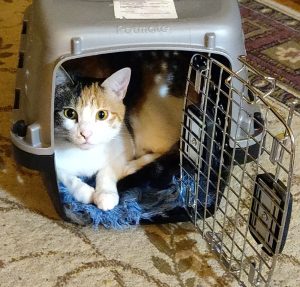

If cooperative care is so great, why isn't everyone doing it?
There is the misconception that it takes too long.
There’s a quote attributed to horse trainer Pat Parelli: “Take the time it takes, and it will take less time.”
Cooperative care takes more time initially to do the training, but it will save lots of time and make things easier in the long run.
People feel less safe when they aren't in control.
We humans like to think we’re in control, but as anyone who has shared their life with a cat can tell you, you can’t make a cat do anything! The idea of “owning” a cat seems preposterous. Control is an illusion. Much as we try, we can’t control the world around us, and we can’t control another individual’s reactions.
Think about it...
What’s safer, holding a snake’s head so they can’t bite you, or gently scooping the snake up, supporting their belly? A lot of people would say the first one, but think about how the snake is going to react. If you grab their head, they are immediately going into fight-or-flight. They are way more likely to try to bite you! If you mess up the hold, you will get bitten. If you scoop them up gently, either with your hands or with a snake hook, they are less likely to be afraid.
When we let the cat initiate the procedure and tell us when to pause, they are in fact more likely to opt in, and the procedure will be safer and less stressful for all involved. Then, you don’t have to feel like the bad guy for forcing your cat into a scary situation.
Objections
With cooperative care especially, I want to emphasize that there are no prerequisites and training is not linear. It’s impossible to create a step-by-step procedure that’s going to work for everyone. Inevitably, someone will have an objection. “I can’t do that because my cat doesn’t like treats.” or “I can’t do that because my cat is afraid of the carrier.” I know because I was that person. “I can’t do that because my cats haven’t learned a chin rest” was one for me. When we identify obstacles, then we can find an alternate starting point that will set us up for success.
Where can I learn more?
For cats, check out this library of demo videos: cattrainingandhandlingvideos.
For community discussion, check out the Facebook Group Cooperative Care with Deb Jones.
Do you offer cooperative care consultations?
Yes! I offer a cooperative care consultation package that includes an initial consultation and 2 follow-ups. You tell me your goals for your cat. If it’s a specific procedure, we get the details from the vet so we make sure our training lines up with what they plan to do. We figure out a starting point, implement our first steps, assess, and adjust as needed.
